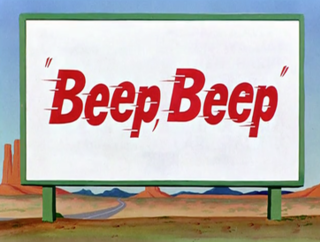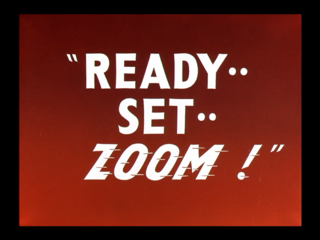Related Research Articles

Wile E. Coyote and the Road Runner are a duo of cartoon characters from the Looney Tunes and Merrie Melodies series of animated cartoons, first appearing in 1949 in the theatrical cartoon short Fast and Furry-ous. In each episode, the cunning, devious and constantly hungry coyote repeatedly attempts to catch and subsequently eat the Road Runner, but is always humorously unsuccessful in doing so. Instead of his animal instincts, the coyote uses absurdly complex contraptions to try to catch his prey. They comically backfire, with the coyote often getting injured in slapstick fashion. Many of the items for these contrivances are mail-ordered from a variety of companies implied to be part of the Acme Corporation.

Fast and Furry-ous is a 1949 Warner Bros. Looney Tunes cartoon, directed by Chuck Jones and written by Michael Maltese. The short was released on September 17, 1949, and stars Wile E. Coyote and the Road Runner, in their debut.
Lickety-Splat is a 1961 Warner Bros. Looney Tunes theatrical animated short directed by Chuck Jones and Abe Levitow. The short was released on June 3, 1961, and stars Wile E. Coyote and the Road Runner.

Beep, Beep is a 1952 Warner Bros. Merrie Melodies series directed by Chuck Jones. The short was released on May 24, 1952, and stars Wile E. Coyote and the Road Runner. The cartoon is named after the sound the Road Runner makes, which is also known as "Meep, meep".

Zipping Along is a 1953 Warner Bros. Merrie Melodies cartoon directed by Chuck Jones. The short was released on September 19, 1953, and stars Wile E. Coyote and the Road Runner.

Stop! Look! And Hasten! is a 1954 Warner Bros. Merrie Melodies cartoon, directed by Chuck Jones. The short was released on August 14, 1954, and stars Wile E. Coyote and the Road Runner. The title is a play on the railroad crossing safety phrase "stop, look, and listen". The cartoon has been featured in the film The Shining. Danny Torrance and his mother, Wendy Torrance, are seen watching this cartoon.

Ready, Set, Zoom! is a 1955 Warner Bros. Looney Tunes cartoon directed by Chuck Jones. The short was released on April 30, 1955, and stars Wile E. Coyote and the Road Runner.

Guided Muscle is a 1955 Warner Bros. Looney Tunes cartoon directed by Chuck Jones. The short was released on December 10, 1955, and stars Wile E. Coyote and the Road Runner.

There They Go-Go-Go! is a 1956 Warner Bros. Looney Tunes cartoon directed by Chuck Jones. The short was released on November 10, 1956, and stars Wile E. Coyote and the Road Runner.

Scrambled Aches is a 1957 Warner Bros. Looney Tunes cartoon directed by Chuck Jones. The short was released on January 26, 1957, and stars Wile E. Coyote and the Road Runner. The title is a pun on scrambled eggs.

Zoom and Bored is a 1957 Warner Bros. cartoon, being a part of the Merrie Melodies series and directed by Chuck Jones. The short was released on September 14, 1957, and stars Wile E. Coyote and the Road Runner.

Whoa, Be-Gone! is a 1958 Warner Bros. Merrie Melodies cartoon directed by Chuck Jones. The short was released on April 12, 1958, and stars Wile E. Coyote and the Road Runner.
Hook, Line and Stinker is a 1958 Warner Bros. Looney Tunes cartoon directed by Chuck Jones. The title is a pun on the idiom Hook, Line and Sinker. The short was released on October 11, 1958 with The Old Man and the Sea, and stars Wile E. Coyote and the Road Runner. When shown on Boomerang USA, this short plays in PAL audio.
Zoom at the Top is a 1962 Merrie Melodies cartoon directed by Chuck Jones and designer Maurice Noble. The short was released on June 30, 1962, and stars Wile E. Coyote and the Road Runner.

Gee Whiz-z-z-z-z-z-z is a 1956 Warner Bros. Looney Tunes cartoon directed by Chuck Jones. The short was released on May 5, 1956, and stars Wile E. Coyote and the Road Runner.

Soup or Sonic is an animated cartoon in the Merrie Melodies series, starring Wile E. Coyote and the Road Runner. It was first aired on May 21, 1980 as a part of the television special Bugs Bunny's Bustin' Out All Over and was one of three new cartoons released. This is the only canonical cartoon in which Wile E. Coyote catches the Road Runner without him escaping afterward, although due to the existing circumstances, Wile E. is physically unable to actually eat the Road Runner.
Road Runner a Go-Go is a 1965 Warner Bros. Merrie Melodies cartoon directed by Chuck Jones, Maurice Noble and Tom Ray. It is one of three cartoons reused from the unsold pilot Adventures of the Road Runner. The short was released on February 1, 1965, and stars Wile E. Coyote and the Road Runner.
Quick Brown Fox and Rapid Rabbit were a pair of Warner Bros. cartoon characters, created by Robert McKimson, who appeared in only one cartoon, Rabbit Stew and Rabbits Too! Future cartoons featuring the characters were planned, but were cancelled following the shutdown of Warner Bros.-Seven Arts Animation on October 10, 1969.
Chaser on the Rocks is a 1965 Warner Bros. Merrie Melodies theatrical animated short directed by Rudy Larriva. The short was released on December 25, 1965, and stars Wile E. Coyote and the Road Runner. The title is a pun on the phrase: "Water on the Rocks".
Clippety Clobbered is a 1966 Warner Bros. Looney Tunes theatrical animated short directed by Rudy Larriva. The short was released on March 12, 1966, and stars Wile E. Coyote and the Road Runner.
References
- ↑ Beck, Jerry; Friedwald, Will (1989). Looney Tunes and Merrie Melodies: A Complete Illustrated Guide to the Warner Bros. Cartoons. Henry Holt and Co. p. 357. ISBN 0-8050-0894-2.
- ↑ Lenburg, Jeff (1999). The Encyclopedia of Animated Cartoons. Checkmark Books. pp. 128–129. ISBN 0-8160-3831-7 . Retrieved 6 June 2020.